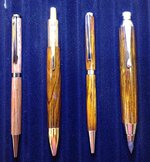K-9 Man
Member
Hello,
I was hoping someone could tell me why the CA finish on the attached blank turned out the way it did. Some of it looks really nice and clear/dark other spots look milky/cloudy. I am new at the CA finish and until now have had good luck. I say luck because I am not sure exactly what I am doing applying CA as a finish.
The cloudy spot don't show up until I am using the mirco mesh to sand. I also noticed it when I applied the "one step platic polish" to the CA finish, which I had done before.
Thanks for any tips/help. By the way the wood used here is Cocobolo.
Ernie
I was hoping someone could tell me why the CA finish on the attached blank turned out the way it did. Some of it looks really nice and clear/dark other spots look milky/cloudy. I am new at the CA finish and until now have had good luck. I say luck because I am not sure exactly what I am doing applying CA as a finish.
The cloudy spot don't show up until I am using the mirco mesh to sand. I also noticed it when I applied the "one step platic polish" to the CA finish, which I had done before.
Thanks for any tips/help. By the way the wood used here is Cocobolo.
Ernie




